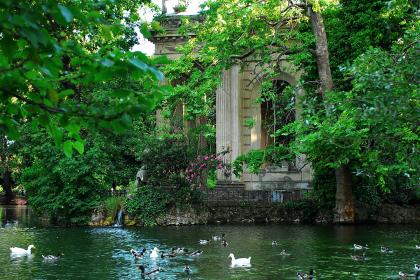
The remains of the ancient Etruscan city of Veii are located near the village of Isola Farnese on a triangular-shaped plateau lapped by two rivers, the Fosso della Mola and the Cremèra, a tributary of the Tiber.
Housing units consisting of huts were present on the plateau already in the Bronze Age and in the Villanovan era (early 9th century BC). Following the growing economic development, due to the control of the lower course of the Tiber and the exploitation of the salt pans on the right bank of the river, as evidenced by the findings of imported Greek ceramics, which also document the intense traffic of Veii with the Greek traders, the the city slowly transformed from a settlement of huts to an urban centre with a city wall made up of blocks of tuff and a powerful aggere (earthen bastion with a moat in front) and with houses built in masonry (7th-6th century BC). The proximity to Rome - just 17 kilometers - led Veii to an inevitable clash for the control of the territory, which ended with the definitive conquest of the city by Furius Camillus in 396 BC. The territory was then annexed to the Roman state, and organized with a series of small farms and rustic villas. After a period of abandonment, a colony was created under Caesar, transformed by Augustus into a municipality with imposing buildings.
After that, the Veiente territory was abandoned again, perhaps as early as the 2nd century AD, until the medieval era, when the village of Isola Farnese was born. Around the city there are numerous necropolises, with mound and chamber tombs which have yielded important funerary objects; among these we must remember the Tomb of the Ducks, which is the oldest Etruscan tomb with wall paintings (second quarter of the 7th century BC) and the Campanian Tomb (end of the 7th century BC), decorated with animal and plant motifs and with figures of knights accompanied by walking characters or fantastic animals.
The sanctuary of Portonaccio is the most important sanctuary in the city, located outside the urban core. The discovery of the famous terracotta statue, placed on the top of the roof of the temple and depicting Apollo (now preserved in Villa Giulia Museum), has erroneously attributed the sanctuary to Apollo. The complex, enclosed by a border wall (temenos), is made up of a temple with an adjoining swimming pool used for ritual purposes, and a square, where the votive offerings offered by the faithful were probably placed, with a large quadrangular platform in the center of which was a square altar. It is the oldest and most notable example of a Tuscan temple known so far: it had three cells or a single cell with lateral colonnades, and presented a rich terracotta decoration composed of covering slabs, antefixes with heads of Gorgons and maenads, and by acroterial statues placed on the top of the roof, including that of Apollo. It was originally adorned with a splendid polychrome terracotta decoration culminating on the top of the roof in a series of larger-than-life-size statues, including the famous late-archaic group of Apollo and Hercules, faced in the struggle for possession of the Cerinite doe from golden horns. Next to the temple there was a pool intended for ritual ablutions and, further east, a large altar. From the dedicatory inscriptions and the acroterial and votive statues we know that Minerva and Apollo must have been venerated in the sanctuary. The decoration can be dated to the end of the 6th century BC, and is attributed to the workshop of Vulca, an Etruscan artist who was also responsible for the decoration of the temple of Capitoline Jupiter on the Capitoline Hill at the time of Tarquinius the Proud (509 BC). The other important sanctuary of Veii is that of Campetti, dedicated to the underworld divinity Veii, eponym of the city, perhaps to be identified with Demeter.
Veii is also known for the presence of a system of underground tunnels built by skilled Etruscan engineers, among these of particular beauty is the Ponte Sodo along the Crèmera ditch: it is a tunnel approximately 70 meters long, dug to facilitate the flow of the river Cremèra during floods, on whose vault wells were drilled to draw water from above. Its dating appears uncertain, between the Etruscan period (6th century BC) and the period following the Roman conquest.
Photo: by Marco Scataglini - Archaeological Park of Veio Campetti, detail of the Roman paving
Veio Regional Park

 Condividi
Condividi
ETRU - National Etruscan Museum of Villa Giulia

 Condividi
Condividi
Villa Borghese

 Condividi
Condividi
Information
More information on the official website.
 Condividi
Condividi
Location
To find out about all accessibility services, visit the Rome accessible section.











































